Contraception - Different Birth Control, Family - planning methods
There are many types of contraception widely used now a days for the purposes of family planning. Every method has its advantages and suits special cases and doesn’t necessarily suits others, and the choice of contraception depends on different needs of the patients like the period of contraception, and also your doctor should decide which method suits your needs more. No method of contraception is completely effective, and failure rates for most reversible methods are strongly influenced by compliance.
Types of contraception:-
- Mechanical contraception
- Hormonal contraception
- Surgical contraception
Mechanical method of contraception:-
* IUD: It is a device that is designed to be inserted into the uterine cavity. It is available in different shapes and sizes. It could be composed of copper, polyethylene, or sometimes with a hormone component that controls the heavy bleeding in addition to its contraceptive effects (MIRENA IUD).
* Rhythm method for contraception:
This method can be used for patients with regular cycles only.
This is done depending on the exact knowledge of ovulation day and avoiding intercourse during the days before and after ovulation; for example, in a regular period that occurs every 28 days, the exact day of ovulation should be day 14, so intercourse should be avoided four to five days before and after this days. Many methods were found to detect ovulation days;
- Increase in body temperature by about o.5 C.
- Change in type of cervical mucous
- You can easily find ovulation kits these days for ovulation day detection by measuring LH surge.
Diaphragm and cup for contraception:-
These devices are made of plastic, and take different shapes and sizes and act as a barrier preventing the seminal fluid from entering the cervix. They are placed vaginally before intercourse and are sometimes coated with a spermicidal gel to increase their efficacy. The size should be adjusted by the doctor.
Suppositories for contraception:-
Spermicidal preparations applied vaginally before intercourse.
Male and female condoms:-
- Male condoms:
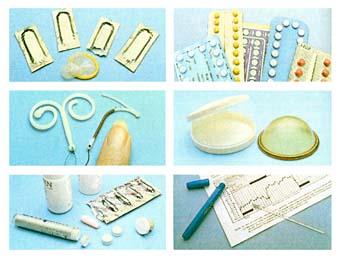 Devices made of latex lubricated with spermicidal agents designed to cover the erect penis and capable of destroying sperms.
Devices made of latex lubricated with spermicidal agents designed to cover the erect penis and capable of destroying sperms.
Usually incorporated into an inner base, which itself may impair sperm activity, e.g. nonoxynol-9,0. These are available as creams, jellies, foaming tablets, pessaries, and aerosols. Condoms are safe and effective, unless they are perforated during use. - Female condom:-
Polyurethane sheath with its open end attached to a flexible polyurethane ring. Spermicidal agents may be used with it. It is not a very popular method.
Hormonal contraception:-
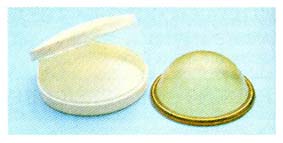
1- Contraceptive pills
The most commonly used contraceptive method worldwide, especially India, China, and South Africa.
Ovulation arrest will be induced by the hormones in these pills, thus preventing pregnancy.
There are many types of oral contraceptive pills differing in the concentration and type of estrogen and progesterone used.
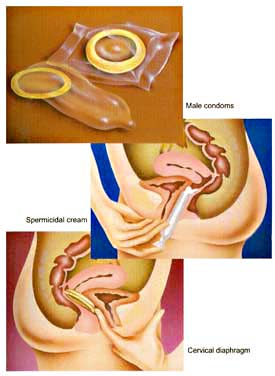
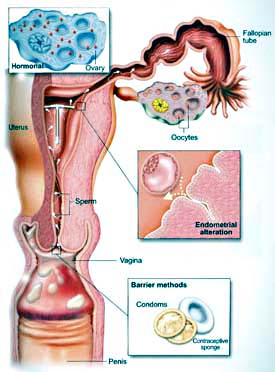
Combined oral contraceptive pills (COC):
This type contains estrogen, usually ethinyl estradiol and progesterone. The dose of estrogen varies from 20-50 mg; the low- dose pills, 30-35 mg, are much safer since the cardiovascular risks of the pills are mainly due to estrogen. Combined pills are available as monophasic preparation in which every pill in the packet contains the same dose of steroid and biphasic and triphasic preparation in which the dose of both steroids changes, once or twice during the cycle because this regimen mimics the normal cycle and produces better cycle control.
Mode of action of oral contraceptive pills:-
The principal mode of action is inhibition of ovulation. Estrogens inhibit pituitary FSH, thus suppressing the development of ovarian follicle while progesterone inhibits the surge of the luteinizing hormone (LH).
Advantages of using combined contraceptive pills as contraceptive method :-
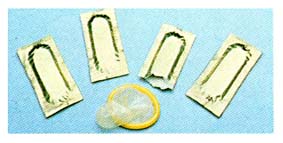
- It regulates menstrual cycles.
- Bleeding amount gets less
- Duration of the cycle gets shorter
- Decreases premenstrual symptoms and dysmenorrhea
- chances of having benign breast lumps, functional ovarian cyst, endometriosis, acne vulgaris, and possibly pelvic inflammatory disease will be increased.
- There is substantial evidence that COC protects against ovarian and endometrial cancer.
Disadvantages and side effects of oral contraceptive pills:-
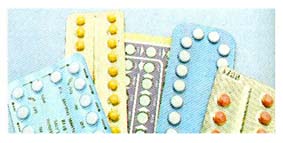
- * Weight gain
- * Fluid retention
- * Nausea and vomiting
- * Cloasma
- * Mood changes
- * Breast enlargement and mastalgia
- * Loss of libido
- * Tendency to hypercoagulability, risk of DVT (deep-vein thrombosis) and hypertension, and also the risk of myocardial infarction, especially if associated with smoking.
Contraindications to using oral contraceptive pills
Absolute contraindication to oral contraceptive pills:-
- Ischemic heart disease
- Valvular heart disease
- Arterial thrombosis
- Venous thrombosis
- CVA (cerebrovascular accidents)
- Vascular malformation in the brain
- Pulmonary hypertension
- Hyperlipidemia
- Migraine
- Active liver disease or tumor
- Gall stones
- Porphyria
- Oestrogen dependent neoplasm
- Trophoblastic disease
- Undiagnosed genital tract bleeding
Relative contraindication to oral contraceptive pills:-
- History of arterial and venous disease in the family. Smoking, advanced age, obesity, diabetes mellitus, and migraine are additional risk factors to taking COC.
- Hyperprolactinaemia, since oestrogen, stimulates the lactotrophes, increasing prolactin secretion.
Progestogen- only pills :-
This was introduced to avoid the side effects of estrogen. It prevents pregnancy by inhibiting ovulation, changes cervical mucus reducing sperm permeability and transport. It also has an effect on the endometrium that compromises implantation.
Indications to Progestogen- only pills:-
It is commonly prescribed for women in whom oestrogen is absolutely or relatively contraindicated.
Contraindications to Progestogen- only pills:-
Absolute Contraindications:-
- Known or suspected pregnancy because it leads to masculinization of the genitalia of the female fetus.
- Undiagnosed irregular uterine bleeding
- Recent history of serious cardiovascular disease.
Relative Contraindications:-
- Severe obesity
- Breast cancer
- Molar pregnancy
- Severe hypertension
- History of recurrent ovarian cyst
- Chronic liver conditions
Side effects to Progestogen- only pills:-
Irregular bleeding, headache, nausea, bloating, breast tenderness, and mood changes.
2. Injectable progestogen:-
Long-acting injections of Norethisterone-enanthate (NET-EN) and medroxy progesterone acetate (MPA) is given as intramuscular injection of 150 mg/ 12 weeks. It prevents ovulation.
Side effects to Injectable progestogen:-
- Inappropriate for women wishing short-term contraception because it may take one year to return to normal fertility after cessation of treatment.
- Weight gain and reduction in bone mineral density (BMD)
- Prolonged amenorrhea and irregular cycles.
- Spotting.
3-Progestogen only implants:-
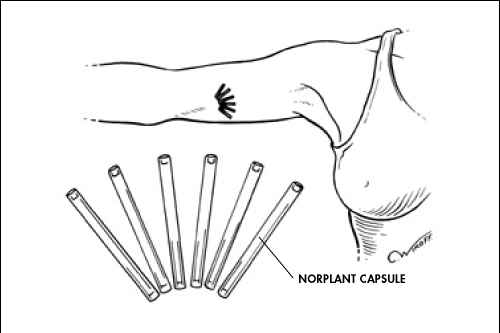
Norplant is a long-acting hormonal method of contraception consisting of six flexible capsules releasing a low dose of levenorgestrel 30-35 mg/ 24 hours for 18 months. First local anesthesia is given then. The capsules are inserted subdermally in the inner aspect of the upper arm. Insertion and removal are minor surgical procedures, which require specialized training. It lasts for five years and fertility returns rapidly after removal. Side effects to such a regimen are menstrual disturbances with a very low failure rate.
Recently, a new hormonal therapy has been used for males to suppress sperm production. The technique consists of implanting rods that contain the hormones testosterone and progestin into the arm of the man under local anesthesia. They last long and are very effective and easily removed after 12 weeks after insertion. Testosterone acts by turning off the signal from the pituitary gland that stimulates the testis to produce sperms, and progestin acts directly on the testis to decrease sperm production.
Surgical contraception
1. Female sterilization
Surgical female sterilization is done by blocking both fallopian tubes by three ways:
Laparotomy minilaparatomy laparoscopy
Laparotomy: Bilateral salpingectomy or hysterectomy may be preferable when there is a coexistent pathology while the other two ways are preferred because they are more effective and safe.
Methods of tubal occlusions:-
- *Tubal ligation by sutures, whether absorbable or non-absorbable, the ends left free or buried in the broad ligament or uterine cornue.
- *Using bipolar diathermy for electrocauterisation allows only the tissue held between the jaws of the forceps to be cauterized.
- *Falope ring: a specially designed applicator is used to place a ring of silicone or rubber over a loop of the tube. This destroys two to three cm of the tube.
- *Clips: A variety of clips are available: Hulka-clemens clip (stainless steel and polycarbonal and filshie clip) (titanium lined with silicon rubber). In this method, a smaller length of the tube is destroyed as compared to the ring.
- *Laser: using CO2 laser divides the tube very cleanly but may allow a high incidence of recanalization.
- *A number of chemical agents have been tested for their ability to occlude the Fallopian tube when installed into the tube either directly or transcervically via the uterus, e.g. 252 mg quinacrine pellet inserted through IUD inserter passed through the cervix. Inflammation and fibrosis will result and can occlude the tubes. However, the safety of using quinacrine in sterilization has not yet been determined, so the surgical method is safer.
2-Male sterilization:-
Vasectomy:-surgical occlusion of the vas deferens to prevent the passage of sperm.
Methods:-
- Clips
- Diathermy
- injection of sclerosing agents percutaneously or occlusive substances (such as silicone used in China).
The success of the procedure is verified by the absence of sperms from two consecutive samples of ejaculate collected at least four weeks apart. Using other contraception must be continued until confirmation of two negative semen results has been achieved, and this is achieved after 16-18 weeks of performing the vasectomy.
Points discussed before using any contraceptive method:
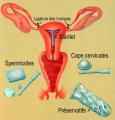
- *Use of COC for curing menstrual symptoms.
- *Size of the family and possible desire for future pregnancy.
- *Maternal disease threatening her life.
- *Sexual life pattern.
- *Maternal age and risk of side effects.
- *Reversibility of the method used.
- *Educational state of couples.
- *Cost.
- *Choosing which partner to sterilize.
Reversal of sterilization
This is required if the sterilization was done at a young age or immediately postpartum or after a therapeutic abortion. A change of partner is the commonest reason for requesting reversal.
Reversal of female sterilization involves laparotomy, but may fail. Microsurgical techniques are associated with around 70% success and carry a high risk of ectopic pregnancy. Ovulation should be confirmed and semen analysis done before reversal is undertaken. Reversal of vasectomy is technically feasible in many cases with patency rate 90%, but pregnancy rate reaches only 70%, and may be due to antisperm antibodies.
Emergency contraception
If you have had unprotected sex (without contraception) or think your method might have failed there are two emergency methods you can use. The emergency hormonal pill – must be taken up to three days (72 hours) after sex. The earlier it is taken after sex the more effective it will be. If you want to use IUD, it must be inserted up to five days after sex, or up to five days after the earliest time you could have released an egg (ovulation).
Dr Najeeb Layyous F.R.C.O.G
Consultant Obstetrician, Gynecologist and Infertility Specialist







 Pregnancy Due Date Calculator
Pregnancy Due Date Calculator
 Chinese Gender Predictor
Chinese Gender Predictor
 Ovulation Calculator
Ovulation Calculator
 IVF Due Date Calculator
IVF Due Date Calculator
